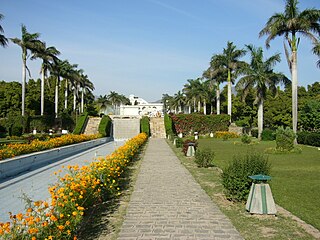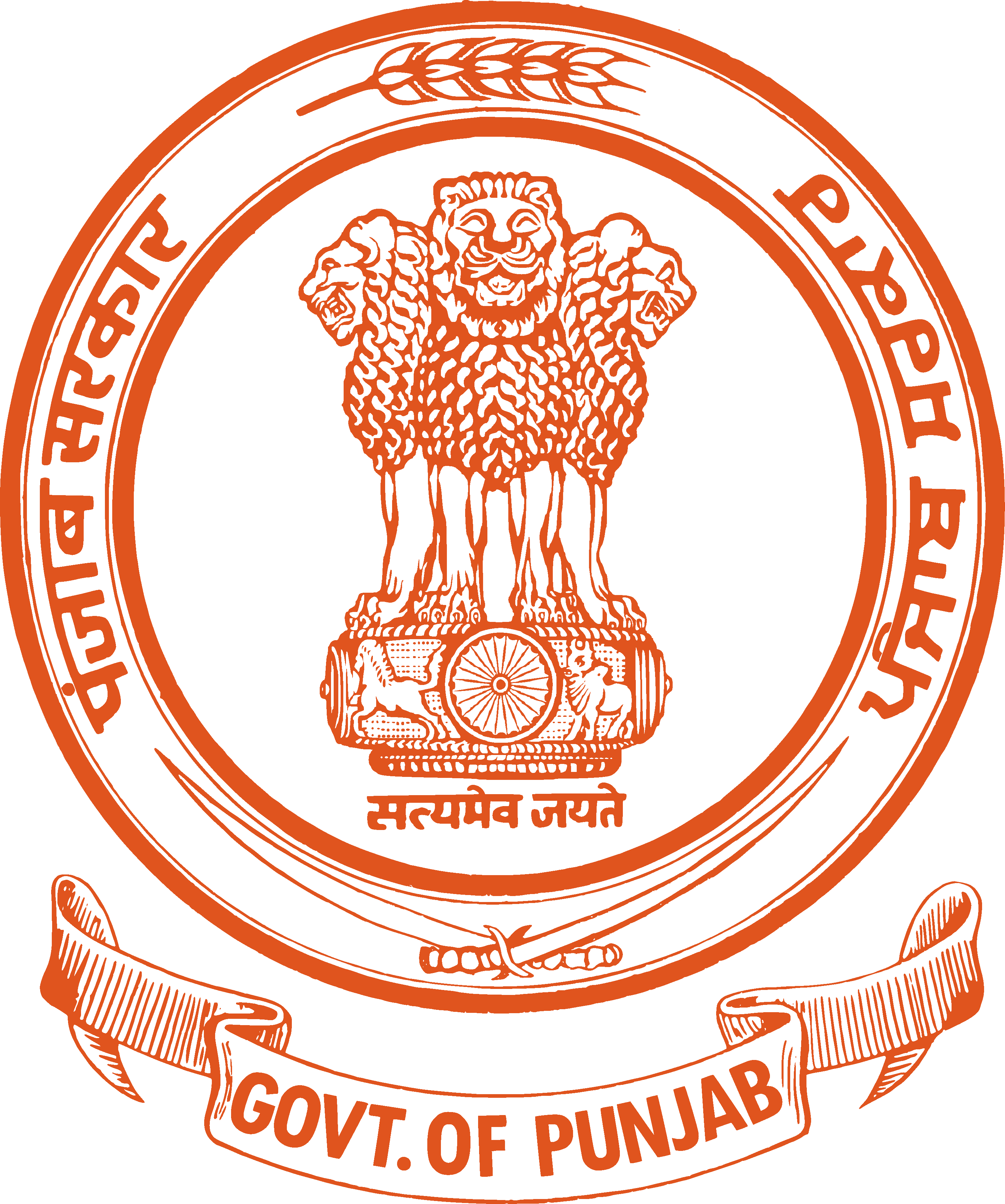Related Research Articles

Patiala is a city in southeastern Punjab, northwestern India. It is the fourth largest city in the state and is the administrative capital of Patiala district. Patiala is located around the Qila Mubarak constructed by the Sidhu Jat chieftain Ala Singh, who founded the royal dynasty of Patiala State in 1763, and after whom the city is named.

Dhol can refer to any one of a number of similar types of double-headed drum widely used, with regional variations, throughout the Indian subcontinent. Its range of distribution in India, Bangladesh and Pakistan primarily includes northern areas such as the Punjab, Haryana, Delhi, Kashmir, Sindh, Assam Valley, Uttarakhand, West Bengal, Odisha, Gujarat, Maharashtra, Konkan, Goa, Karnataka, Rajasthan, Bihar, Jharkhand and Uttar Pradesh. The range stretches westward as far as eastern Afghanistan. A related instrument is the dholak or dholki.

Holi is a popular ancient Indian festival, also known as the "Festival of Love", the "Festival of Colours" and the "Festival of Spring". The festival celebrates the eternal and divine love of Radha Krishna. It also signifies the triumph of good over the evil, as it celebrates the victory of Vishnu as Narasimha Narayana over Hiranyakashipu. It originated and is predominantly celebrated in India and Nepal but has also spread to other regions of Asia and parts of the Western world through the diaspora from the Indian subcontinent.

Music of Punjab reflects the traditions of the Punjab region of the Indian subcontinent, currently divided into two parts: East Punjab and West Punjab. The Punjab has diverse styles of music, ranging from folk and Sufi to classical, notably the Patiala gharana. While this style of music is, obviously, most popular in Punjab, it has seen popularity in many diverse and different areas of the world, such as Southern Ontario.

Lohri is a popular winter folk festival celebrated primarily in the Indian Subcontinent. The significance and legends about the Lohri festival are many and these link the festival to the Punjab region. It is believed by many that the festival marks the passing of the winter solstice. Lohri marks the end of winter, and is a traditional welcome of longer days and the sun's journey to the northern hemisphere by Hindus and Sikhs in the northern region of the Indian subcontinent. It is observed the night before Makar Sankranti, also known as Maghi, and according to the solar part of the lunisolar Vikrami calendar and typically falls about the same date every year.

Phulkari refers to the folk embroidery of the Punjab. Although Phulkari means floral work, the designs include not only flowers but also cover motifs and geometrical shapes. The main characteristics of Phulkari embroidery are use of darn stitch on the wrong side of coarse cotton cloth with coloured silken thread. Punjabi women create innumerable alluring and interesting designs and patterns by their skilful manipulation of the darn stitch. According to Kehal (2009), a cloth where only a few flowers are embroidered is called a Phulkari. The other types are distinct varieties. The traditional varieties of Phulkaris are large items of cloth and include Chope, Tilpatr, Neelak and Bagh. Sometimes, the Bagh is given separate categorization of its own as on other varieties of a Phulkari, parts of the cloth is visible, whereas in a Bagh, the embroidery covers the entire garment so that the base cloth is not visible. Further, in contemporary modern designs, simple and sparsely embroidered dupattas, odhinis, and shawls, made for everyday use, are referred to as phulkaris, whereas clothing items that cover the entire body, made for special and ceremonial occasions such as weddings are called baghs. The Phulkari continues to be an integral part of Punjabi weddings to the present day.
Gair dance is one of the popular, famous folk dances from Rajasthan in India which is mostly performed by the Bhil community but found in all over Rajasthan.

Yadavindra Gardens, also known as Pinjore Gardens, is a historic 17th century garden located in Pinjore city of Panchkula district in the Indian state of Haryana. It is an examples of the Mughal Gardens architectural style, which was renovated by the Patiala Dynasty Sikh Rulers. It was built by Fadai Khan.
Boliyan or bolis are couplets that are sung in Punjab. Boliyan are often sung in accompaniment of bhangra dances.
Qila Raipur Sports Festival, popularly known as the Rural Olympics, is held annually in Qila Raipur, in Punjab, India. Competitions are held for major Punjabi rural sports, include cart-race, athletic events and rope pulling.
Paramjit Singh Sidhu, professionally known as Pami Bai, is an Indian singer, songwriter and Bhangra dancer from Patiala.

A bell-ringer is a person who rings a bell, usually a church bell, by means of a rope or other mechanism.

Punjab is a state in northern India. Forming part of the larger Punjab region of the Indian subcontinent, the state is bordered by the Indian states of Himachal Pradesh to the north and northeast, Haryana to the south and southeast, and Rajasthan to the southwest, by the Indian union territory of Chandigarh to the east, and by the region of Jammu and Kashmir administered by India as a union territory, to the north. It is bordered by Punjab, a province of Pakistan to the west. The state covers an area of 50,362 square kilometres, 1.53% of India's total geographical area. It is the 20th-largest Indian state by area. With over 27 million inhabitants, Punjab is the 16th-largest state by population, comprising 23 districts. Punjabi, written in the Gurmukhi script, is the most widely spoken and official language of the state. The main ethnic group are the Punjabis, with Sikhs and Hindus as the dominant religious groups. The state capital is Chandigarh, a Union Territory and also the capital of the neighbouring state of Haryana. The five tributary rivers of the Indus River from which the region took its name are the Sutlej, Ravi, Beas, Chenab and Jhelum rivers; the Sutlej, Ravi and Beas rivers flow through the Indian Punjab.
Punjabi festivals are various festive celebrations observed by Punjabis in Pakistan, India and the diaspora Punjabi community found worldwide. The Punjabis are a diverse group of people from different religious background that affects the festivals they observe. According to a 2007 estimate, the total population of Punjabi Muslims is about 90 million, with 97% of Punjabis who live in Pakistan following Islam, in contrast to the remaining 30 million Punjabi Sikhs and Punjabi Hindus who predominantly live in India.

BhaṅgṛāIPA: [ˈpə̀ŋɡɽaː](listen)) is a type of traditional folk dance of the Indian subcontinent, originating in Sialkot in the Majha area of Punjab. In a typical performance, several dancers execute vigorous kicks, leaps, and bends of the body—often with upraised, thrusting arm or shoulder movements—to the accompaniment of short songs called boliyan and, most significantly, to the beat of a dhol. Struck with a heavy beater on one end and with a lighter stick on the other, the dhol imbues the music with a syncopated, swinging rhythmic character that has generally remained the hallmark of bhangra music. An energetic Punjabi dance, bhangra originated with Punjab farmers as a cultural and communal celebration; its modern-day evolution has allowed bhangra to retain its traditional Indian roots, while broadening its reach to include integration into popular music and DJing, group-based competitions, and even exercise and dance programs in schools and studios.
Punjabi folk music is the traditional music on the traditional musical instruments of the Punjab region of the Indian subcontinent. There is a great repertoire of music from the time of birth through the different stages of joy and sorrow till death. The folk music invokes the traditions as well as the hardworking nature, bravery and many more things that the people of Punjab get from its gateway-to-India geographical location. Due to the large area with many sub-regions, the folk music has minor lingual differences but invokes the same feelings. The sub-regions, Malwa, Doaba, Majha, Pothohar, and hills areas, have numerous folk songs. Punjabi dance OP Bhangra music which is a genre of Punjabi modern music invented in Britain by the Punjabi diaspora.
The 2013 World Kabaddi Cup was the fourth edition of the circle style World Kabaddi Cup, held from December 1 to December 14, 2013 with the Opening Ceremony on November 30, 2013 at Bathinda. The tournament took place in Punjab, India.

Saraswati Wildlife Sanctuary, also known as Seonsar Forest, is situated in Kaithal district of Haryana State, India. It is spread over an area of 4,452.85 hectares.

Punjabis play a wide variety of sports and games, ranging from modern games such as hockey and cricket, to the more traditional games such as Kabaddi, Kushtian (wrestling) and Khuddo khoondi. There are over 100 traditional games and sports of Punjab.
References
- ↑ Singh, Jangveer (10.09.2000) The Tribune: Tipri rhythms are fading out in region accessed 04.10.2019)
- ↑ Mohinder Singh Randhawa. (1960) Punjab: Itihas, Kala, Sahit, te Sabiachar aad. Bhasha Vibhag, Punjab, Patiala.
- ↑ James, Alan, G (1974) Sikh Children in Britain. Oxford University Press.
- ↑ Dhillan, I.S. (1998). Folk Dances of Panjab. National Book Shop. ISBN 9788171162208 . Retrieved 2019-10-05.
- ↑ Singh, Jangveer (10.09.2000) The Tribune: Tipri rhythms are fading out in region accessed 04.10.2019)
